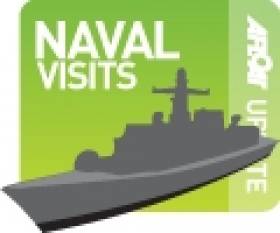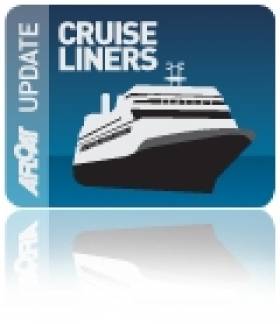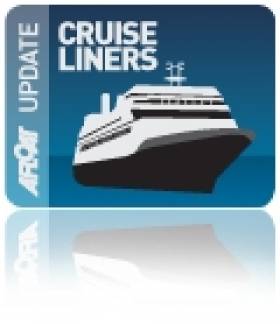Displaying items by tag: Dublin Port
European Naval Flotilla Docks in Dublin
Of the foursome, only ENS Tasuja is the odd one out, she is a diving and support vessel whereas the rest are all a combination of minehunters / minesweepers. ENS Tasuja is from the Lindormen-class and was built in Denmark in 1977. She is 44.5 meters long, has a maximum speed of 14 knots, and has a crew of 28.
HNoMS Maaloey is an Oksøy-class minehunter which has a catamaran hull constructed of fibre-reinforced plastic which has a very low magnetic signature. She can carry two ROV's and the same number of rigid inflatable boats (RIB).
Above: The Norwegian Navy’s catamaran minehunter HNoMS Maaloey detonates a sea-mine
She is almost identical to the Alta-class leadship HNoMS Alta which provided escort duties during the official state visit of King Harald V and Queen Sonja of Norway, on board the royal yacht K/S Norge in 2006. She arrived in Irish waters, firstly calling to Dun Laoghaire Harbour, where the royal couple boarded the royal yacht at the East Pier. From there she sailed the short distance across the bay to Dublin Port and her last Irish call was to Cork.
ORP Flaming is a mine countermeasures vessel which operates in minesweeping and minehunting. The vessel is designed to trace such devices and make safe fairways for shipping. She can detect anchored mines 1600m from the ship and bottom mines located 600m below the ship's keel. In addition she can lay mines of six different types.
FGS Überherrn is a Kulmbach Class minehunter, in service with the German Navy since commissioning in 1989. She was originally built as a Hameln Class (SM 343) minesweeper by STN Systemtechnik Nord, but was converted to the Kulmbach Class. She has an overall length of 54.4m, a width of 9.2m and a draft of 2.5m and a displacement of 635 tonnes. Armament comprises two, four-cell Stinger missile launchers firing FIM-92 Stinger surface-to-air missiles. There are a crew of 37, which includes four officers, 20 petty officers and 13 ratings.
The flotilla are moored two abreast alongside Sir John Rogersons Quay (berth No. 8), which is located on the south quays between the Samuel Beckett and East-Link Bridges. Of the four naval ships, FGS Überherrn is the first to depart on Sunday, the other vessels are to depart on Monday. The vessels will provide an opportunity to view at close quarters a variety of naval architecture design and navies from northern Europe.
Manx Seasonal Visitor to Dublin Port
Following this mornings Irish route sailing, she resumed on her regular Douglas-Heysham route and she also serves Douglas-Birkenhead (Liverpool) during the winter months.
During the summer Dublin-Douglas sailings are served by fast-ferry catamaran Manannan (1998/5,743grt). The 96m InCAT built in Hobart,Tasmania had also operated Douglas-Belfast high-season crossings. Her roster is now confined to a Douglas-Liverpool sailing schedule.
Ben-My-Chree (photo) is Manx for 'Girl of my heart' and her island owners commissioned the 12,504grt ro-pax from Dutch shipbuilders Van de Giessen-de Noord. The 125m ferry was launched in 1998 and she can accommodate 630 passengers,275 vehicles and 1,235 freight lane-metres.
This particular ro-pax design has also been built for Channel Islands operator Commodore Ferries with their Commodore Clipper and a Scandinavian ferry operator. In addition another Dutch shipbuilder, Merwede built a multi-support vessel (MRV) derived from the design of Ben-My-Chree for the Royal New Zealand Navy when they commissioned HMNZS Canterbury (L421). Click for similar port-side photo view to compare differences.
Incidentally the Manannan prior to entering service last year for the IOMSPCo. was for five years chartered initially to the United States Navy but transferred to the United States Army Forces. To read more click HERE.
Dutch Naval Stealth Frigate On Visit to Dublin Port
The class have two roles, to command operations and deployment of the Royal Netherlands Navy, the Netherlands Maritime Force (NLMARFOR). In addition they are equipped for air-defence tasks and must be capable of providing protection for an entire fleet.
This dual-role task is the reason that the ships are known as air-defence and command frigates (LCF). The frigates all entered service between 2001-2005 and were built by the Royal Schelde Group, of Flushing, Netherlands. The design also involved participated from Spain and Germany.
Dublin Port Turn-Around Offers Direct Cruises to the Sun
With a short-turn around in port, more cruise-goers will be boarding for a mid-afternoon departure, marking the start of a 13-night Canary Islands & Madeira cruise. When she heads out of the port, the first port of call is Falmouth then it's off to Leixoes (Portugal), Agadir (Morocco), Arrecife (Lanzarote), Las Palmas (Gran Canaria), Funchal (Madeira), Lisbon (Portugal) and Vigo (Spain) before returning to Dublin.
The vessels final end-of season cruise from Dublin is on 25 October, with a 10-night cruise to Nice (returning by air). The interim ports of call are to Falmouth, Leixoes, Lisbon, Cartagena (Spain) Palma and Mahon (Menorca). To read more about this cruise click HERE.
In addition to Dublin calls the former Cunard Countess, also called this season to Cork Harbour. It was during a call last month to Ringaskiddy that another 'Cunarder' the flagship, Queen Mary 2 was also in port on a call to Cobh. To read more of that visit click HERE.
Dublin Port: Display of East Wall Life & Docklands
A photographic display of 'Dublin Port and the East Wall' will be held in the Dublin Port Company Centre, Alexandra Road, on Saturday 15th October.
The archives from the ports extensive collection depict how life was for generations who worked in the docklands over the years and the close historical links of the community.
The display forms part of the 'East Wall for All' History Week which runs until 24th October. The programme for events are listed below.
"East Wall - a journey through time" Sean O'Casey Community Centre, Friday 14th October
Dublin Port - a shared history", Port Centre, Alex Rd - Saturday 15th October
Collen - "Two centuries of building", Three Gateway, East Wall Rd. - Wednesday 19th October
"The Shadow of O'Casey", Sean O'Casey Community Centre - Saturday 22nd October
"Shadow of a Gunman" - 18th - 22nd October, Sean O'Casey Community Centre
It is only in recent years that larger vessels can berth at this stretch of the waterfront following the completion of several major construction projects over the last decade. From the building of the Convention Centre and the Samuel Beckett Bridge which involved using the dredger Hebble Sand (click HERE) during its construction process.
In addition the refurbishment of Spencer Dock sea-lock entrance that for many years was closed is now re-opened. The dock entrance featured in the start of the new television series 'Waterways'-The Royal Canal. Episode two is this Sunday on RTE 1 at 8.30pm.
Aside the 79m L.E. Roisin, the last large vessel to berth close to berth 16A was the French 58m tallship Belem, which was chartered by Alliance Francaise to celebrate their 50th anniversary in 2010 and for the inaugural French Hoist the Sail: Market Festival. The three-masted barque built in 1896 was once also owned by the Sir Arthur Ernest Guinness under the name of Fantôme II.
Situated between where L.E. Roisin is currently berthed and where the Belem had moored, is home to the 'resident' M.V. Cill Airne, a floating bar and restaurant dining venue at berth 16B. Another resident is the former lightship Kittiwake at berth 17B, though sited much further downstream at the end of North Wall Quay, opposite the O2 Arena and next to the East-Link Bridge.
There is a fourth resident, again berthed on the north quays, though the Jeanie Johnston unlike her counterparts is moored closer to the city-centre at Custom House Quay. Apart from yachts, leisure-craft and occasional private motor-yachts using the Dublin City Moorings, she is the only vessel to permanently occupy a berth between Samuel Beckett Bridge and the Sean O'Casey foot-bridge.
- inland waterways
- Dublin Port
- Dublin Docklands
- Royal Canal
- Jeanie Johnston
- naval service
- Custom House Quay
- Alliance Française
- Spencer Dock
- Sean O'Casey Bridge
- River Liffey
- Belem
- Sir John Rogersons Quay
- TallShips
- North Wall Quay
- Fantome II
- Dick Warner
- Dublin City Moorings
- Navy News
- O2 Arena
- EastLink bridge
- LE Roisin
- Sir Arthur Guinness
- National Convention Centre Dublin
- Samual Beckett Bridge
Taoiseach Announces Marine Jobs On Visit of RV Celtic Explorer
An Taoiseach Enda Kenny visited the Marine Institute's research vessel RV Celtic Explorer in Dublin Port today, where he announced the creation of 92 jobs in the marine sector, writes Jehan Ashmore.
"Ireland is now recognised as an emerging power in Marine Research and Innovation," said the Taoiseach. Of the new positions, 64 will be generated in the seafood processing sector. This follows a €3.5m Seafood Processing Business Investment Scheme administered by Bord Iascaigh Mhara (BIM). In the area of marine research, 28 jobs have been created through funding of €2m from an International SmartOcean Graduate Programme.
SmartOcean is a collaboration between IRCSET (Irish Research Council for Science Engineering and Technology), the Marine Institute, five Irish universities and key multinationals and SME Information and Communication Technology (ICT) companies to provide funding for 28 research posts.
The Taoiseach said: "This has been achieved through the mapping of the 90% of Irish national territory that lies under the Atlantic, the creation of a quarter of a billion Euros worth of marine research infrastructure, and the fostering of strong linkages between industry and research centres, all of which will support employment opportunities in key areas of potential growth in the marine sector."
During the tour of the RV Celtic Explorer, the Taoiseach who was accompanied by Minister for Agriculture, Marine and Food, Simon Coveney, welcomed the expansion of Ireland's capabilities in the international shipping services sector, which is expected to attract additional jobs to the country.
Ireland's emerging international shipping services sector has continued to grow, underpinned by a number of investments in new and second hand ships over the last twelve months by such companies as Arklow Shipping and the Mainport Group, as well as foreign direct investments by D'Amico and Ardmore shipping.
As reported on Afloat.ie, RV Celtic Explorer had arrived yesterday into Dublin Port, having completed a fisheries demersal survey which started in Galway on 23 September. Initially she had docked at Ocean Pier but she subsequently shifted berths to Sir John Rogersons Quay for today's reception of An Taoiseach. According to her survey schedule she is due to depart tomorrow on a herring acoustic survey which is to take place in the Celtic Sea and off the south-west coast.
- Dublin Port
- BIM
- Marine Institute
- marine science
- Arklow Shipping Ltd
- Bord Iascaigh Mhara
- Ports and Shipping News
- Ardmore Shipping
- Mainport Group
- D'Amico
- Irish marine jobs
- An Taoiseach Enda Kenny
- SmartOcean
- RV Celtic Explorer
- RV Celtic Voyager
- Sir John Rogersons Quay
- Irish research vessels
- Simon Coveney
Poolbeg Welcomes Back Dublin Bay Old Gaffers Winter Talks Programme
Please note that this inaugural talk of the season is on a Wednesday night which is a change from the normally scheduled Tuesday night, mostly starting at 8pm. Those wishing to attend may wish to arrive a bit earlier so to avail of the PYBC's clubhouse facilities, which overlooks its marina in the centre of Dublin Port, opposite Alexandra Basin.
The venue is located on the South Bank, Pigeon House Road, Ringsend which can be accessed from the Sean Moore Road that connects the Merrion Strand Road (from the south) and the East-Link Toll Bridge (from the north). For further information on the DBOGA lectures and more click HERE. In addition information about the PYBC Tel: (01) 668 9983 or logon to www.poolbegmarina.ie/
Dublin Port: As You’ve Never Seen It Before
On board the open-topped yellow tour-boat RIB, an audio commentary firstly informs you about the M.V. Cill Airne, built nearby in the old Liffey Dockyard, nearly fifty year ago. Discover why she was one of the last riveted built vessels in Europe, her days as liner-tender and the rich and famous who threaded her decks.
Heading downstream the former lightship Kittiwake is berthed opposite the O2 Arena. She was one of the last lightships to serve in Irish waters at the South Rock station off Co. Down. In complete contrast a ferris-wheel revolves in the background but no sooner the boat slips under the East-Link Toll-Lift bridge which opened in 1984.
On the other side of the bridge a small non-descript looking grey-hulled motorboat lies at anchor, on her bow is painted the figure 11. So what's the story here!...here's a glue: 'Don't pay the ferry man until you get to the other side!...
Past Poolbeg Marina, giant blue-gantries cranes of the Marine Terminal Ltd (MTL) are busy unloading from Karin Schepers, a containership previously reported on Afloat.ie. Look out for the ports 'graffiti', the work of crews who make their mark by painting the name of their ship and also the mural of the late Ronnie Drew of The Dubliners.
Opposite this terminal is the ports largest basin, Alexandra Basin, named after Queen Alexandra. Subject to port security, the tour may include entering the basin should there be a particular vessel of note.This also allows for views of the dock-gates of the Dublin Graving Dock, one of only three large ship-repair facilities on the island of Ireland. Neighbouring the graving dock is where the Liffey Dockyard once stood.
Before the tour passes the towering twin stacks of the former ESB Poolbeg electricity power station is tucked away Pigeon Harbour. Learn more about its hotel conveniently sited beside where packet-ships regularly plied, essentially the ferryport of its day. Its modern-day counterpart faces opposite on the north quays where up to 17 sailings daily operate on the Irish Sea.
Marvel at the length of the impressive Great South Wall, why was it called 'Great' and why was it built?... What can be revealed is that Captain William Bligh of "Mutiny of the Bounty" fame was a major figure in the project, when the wall was completed in 1795.
The commentary has many more fascinating facts, figures and the occasional anecdote told with typical Dublin wit. So if you live within 80km (50-mile) radius of the capital, then the chances that the shirt you wear, the breakfast cereal you ate and the car you drive, most likely came through Dublin Port as almost 75% of goods serve this hinterland.
More on Dublin Bay here
- Dublin Port
- River Lee
- Sea Safari Tours
- Poolbeg Marina
- River Liffey
- Ports and Shipping News
- ESB
- Karin Schepers
- EastLink bridge
- Dublin Port & River Liffey Tours
- Dublin ferryport
- MV Cill Airne
- ESB Poolbeg powerstation
- Alexandra Basin Dublin Port
- Liffey Dockyard
- Dublin Bay boat operator
- Marine Terminal Ltd
- MTL
Fram From the Fjords and Beyond
Fram operates on cruises from Norway to Spitsbergen, Greenland, and Europe. She also cruises in Antarctic waters and explores the Chilean fjords. She can handle 400 passengers in 254 berths. On board there is a reception area, a large top-deck glass-enclosed observation salon positioned forward, bar, restaurant, library, shop and leisure facilities, including gym, sauna and jacuzzi. For further information and deck plans click HERE.
Throughout her interior she has traditional and modern artwork from a selection of Norwegian and Greenlandic artists. To read more on her Antarctic cruises and other destinations click HERE.
On this particular cruise, she had departed from Bergin and called to several Scottish ports prior to berthing in Belfast and docking in Dublin yesterday. This evening she heads for the Isles of Scilly, followed by a call to Portsmouth before disembarking her passengers in Hamburg.







































































